2014
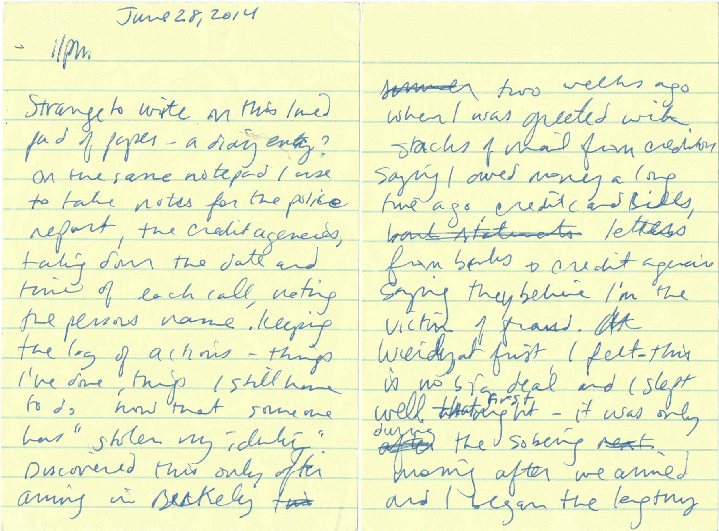
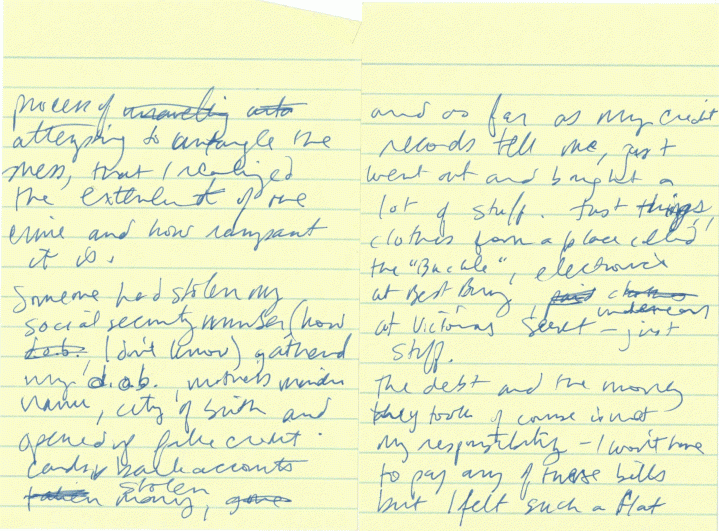
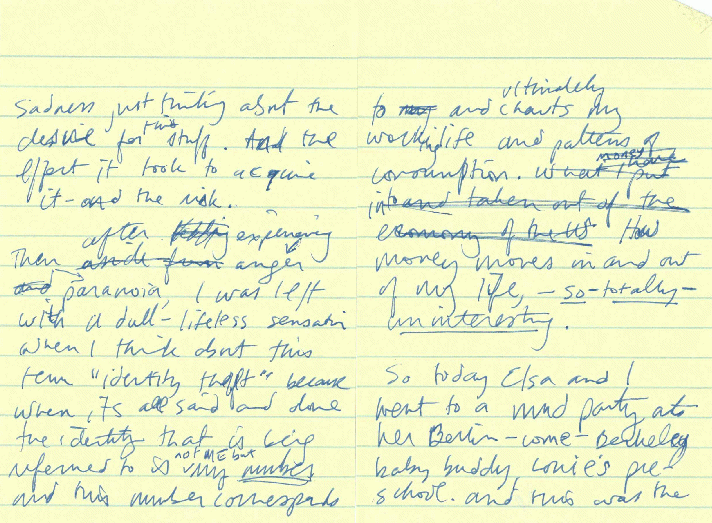
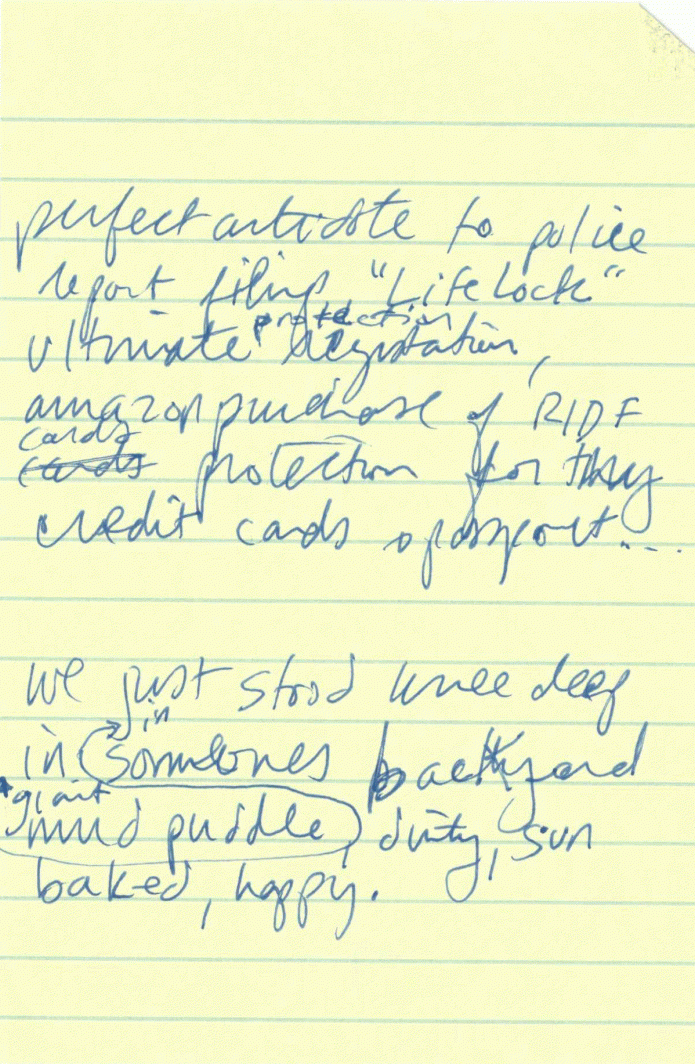
Saturday June 28, 2014
Berkeley, California 1pm
Strange to write on this lined pad of paper- a diary entry?
On the same notepad I am using to take notes for the police report, the credit agencies, taking down the date and time of each call, noting the name of the person I spoke with, keeping the log of actions- things I’ve done, things I still have to do now that my identity has been stolen.
I discovered this only after arriving in Berkeley two weeks ago when I was greeted with stacks of mail from creditors dating back to October 2013 saying that I owed a lot of money (10’s of thousands of dollars). There were current credit card bills mixed in with letters from banks and credit agencies informing me that they believe I have been the victim of fraud- that someone out there is pretending to be me.
Weirdly at first I felt- this is really no big deal- and I slept well that first night. I had naïvely assumed that to have done such a thing the person must have really needed the money badly. It was only during the sobering morning after our arrival that I began to realize the extent of the crime and how rampant it actually is. Then I began the lengthy, tedious process of attempting to untangle the whole mess.
Someone had stolen my social security number (how I don’t know) gathered my date and city of birth, mother’s maiden name and opened up false credit cards and bank accounts and stolen large sums of money in my name. As far as my credit records tell me, they just went out and bought a lot of stuff and they did it like a full time job. They just wanted things- clothes from a place called “Buckle”, electronics at Best Buy, underwear at Victoria’s Secret– just stuff.
The debt and the money they took is of course not my responsibility, in the end I shouldn’t have to pay any of these bills, but I feel such a flat sadness just thinking about the desire for things and to think of the effort it took to acquire them, and the risk.
After experiencing anger then paranoia, I am left with a dull lifeless sensation especially when I think about this term “identity theft” because when it’s all said and done the identity that is being referred to is not ME but the numbers associated with me and these numbers correspond to and ultimately chart my working life and patterns of consumption- the way that money moves in and out of my life.
So totally uninteresting.
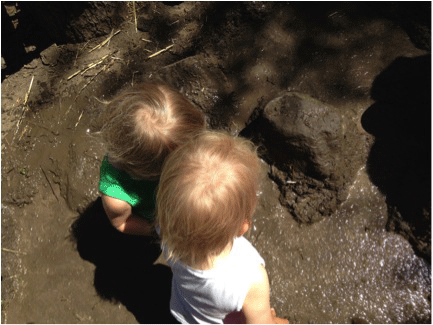
So today Elsa and I went to a mud party at her Berlin-now-Berkeley friend, Louie’s preschool and this was the perfect antidote to the police report filings, the “Life Lock Ultimate” registration, the Amazon purchase of RFID protector shields (sleeves that supposedly protect my credit cards and passport information from someone passing me on the street with an electronic reader that can covertly record all of my information)- well it’s either that or it’s a placebo to make me feel I’m “protected”.
We just stood knee-deep in a giant mud puddle in someone’s backyard, dirty, sun-baked, happy.
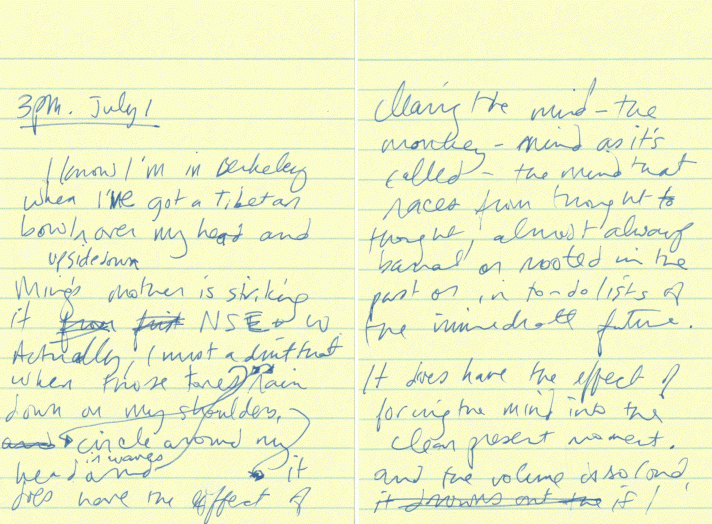

Tuesday July 1, 2014
Berkeley, California 3pm
I know I’m in Berkeley when I’ve got a large Tibetan bowl upside-down over my head and Ming’s mother is striking it north/south/east and west.
Actually, I must admit that when those tones circle around my head in waves and rain down on my shoulders, it does have the effect of clearing the mind- the monkey mind as it’s called- the mind that races from thought to thought, almost always banal or rooted in the past or in the “to-do” lists of the immediate future.
It does have the effect of focusing the mind into the clear present moment.
And the volume is so loud if I close my eyes it drowns out the scene in the kitchen- the constant talk of illness- of how the medical establishment is ruled by pharmaceutical companies and how blindness is treatable through something called “Vortex Healing”
…but who am I to say all of that isn’t true? Who am I to weigh-in on what or who is worthy of trust?
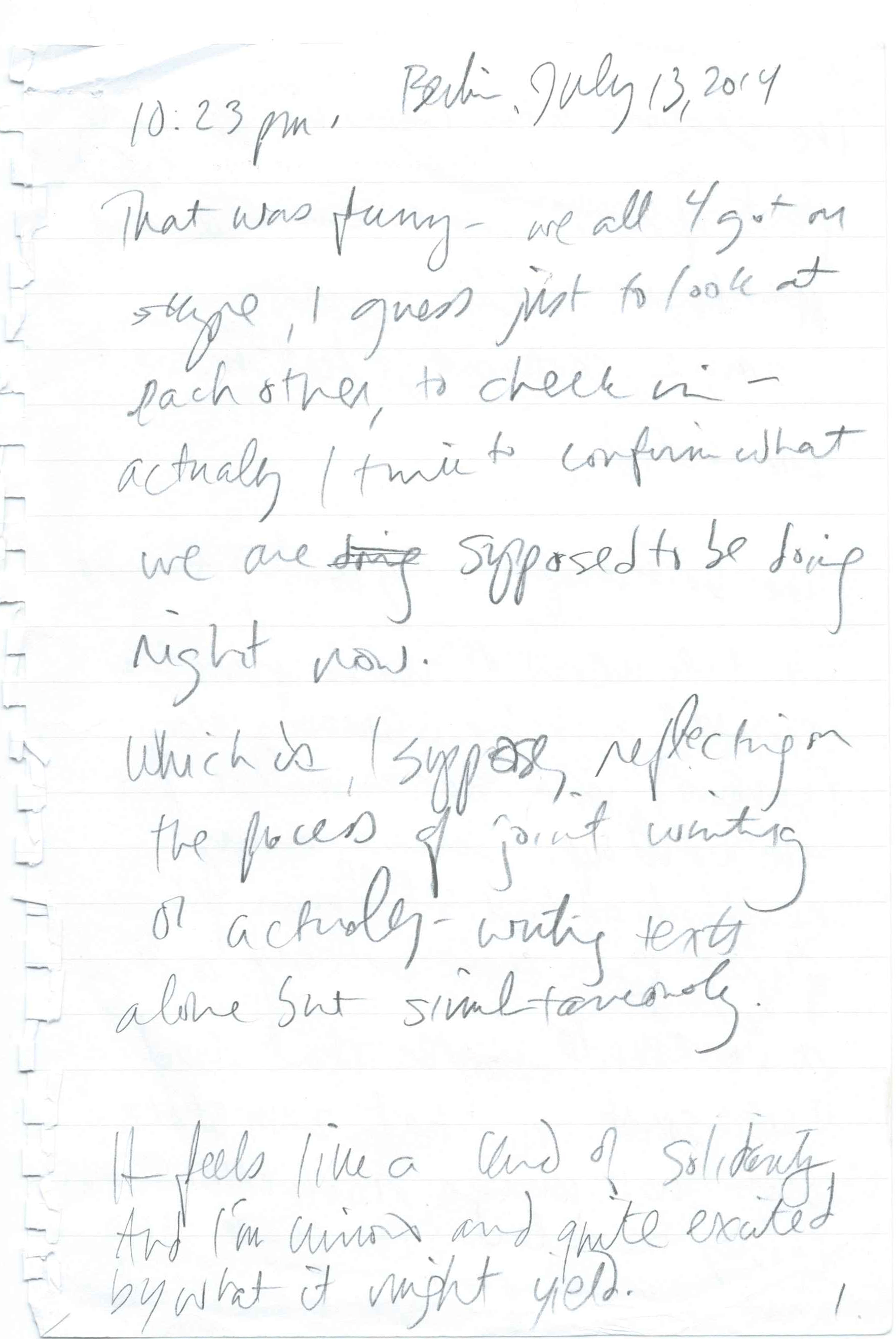
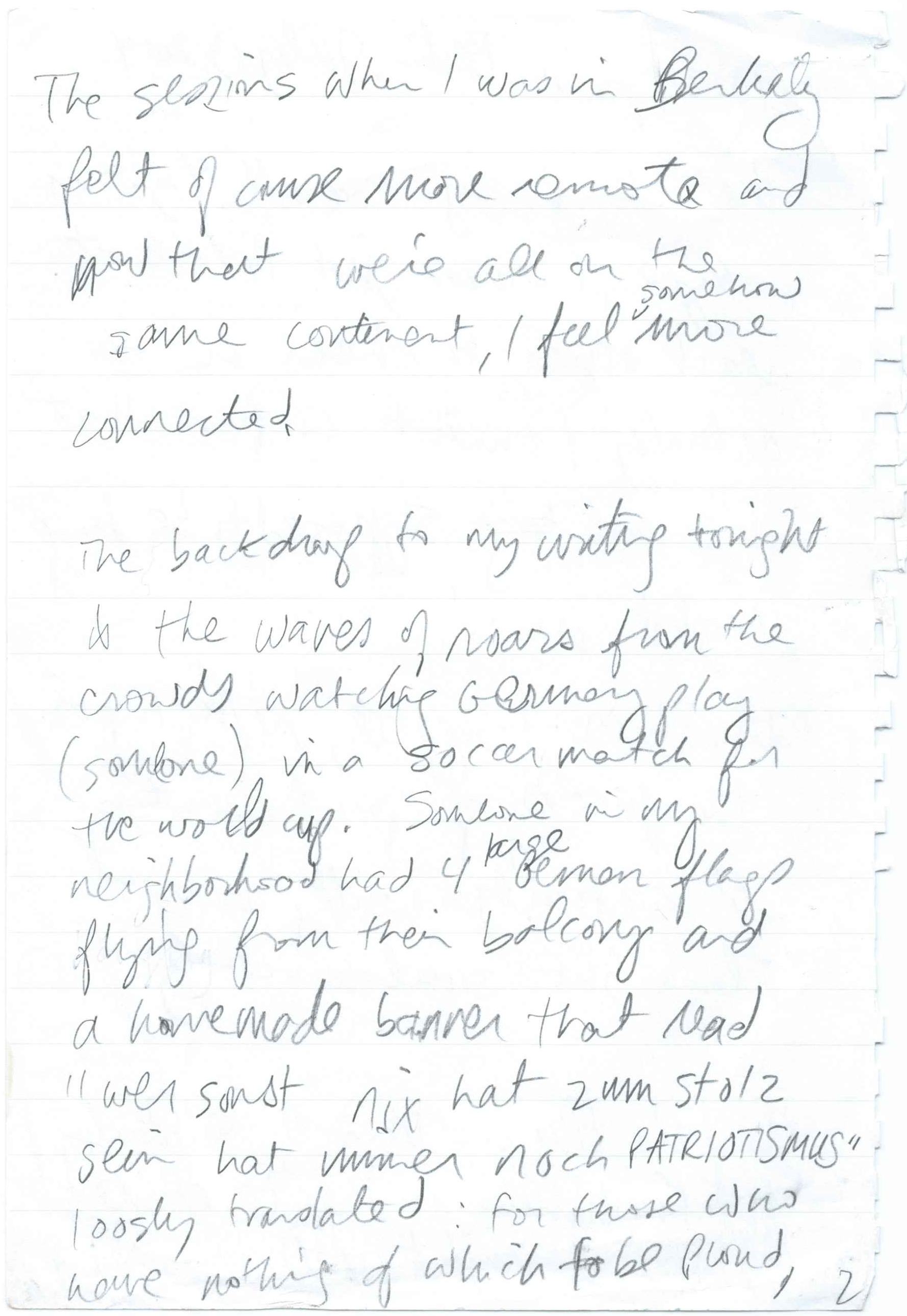
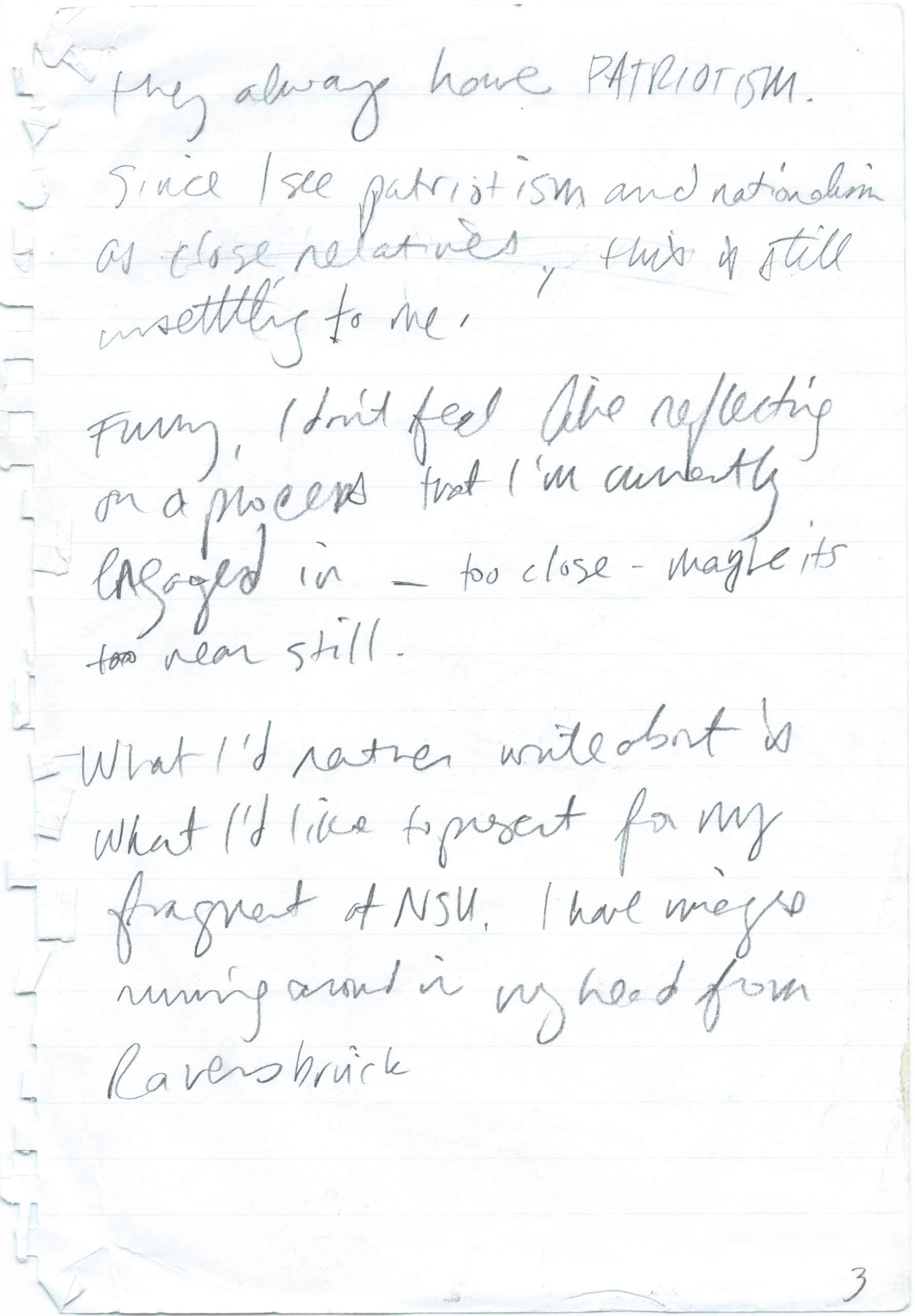
Sunday July 13, 2014
Berlin, Germany 10:23pm
That was funny- we all four (Myna, Per, Camilla and I) got on Skype at the same time although we hadn’t scheduled it. I guess we just wanted to look at each other, to check in- actually I think to confirm what we are supposed to be doing right now, which is I suppose, reflecting on the process of jointly writing, or actually, writing texts alone but simultaneously.
It feels like a kind of solidarity and I’m curious and quite excited by what it might yield.
The sessions when I was in Berkeley felt of course more remote and now that we’re all on the same continent, I feel somehow more connected.
The backdrop to my writing tonight is the waves of roars from the crowds watching Germany play (someone) in a soccer match for the world cup.
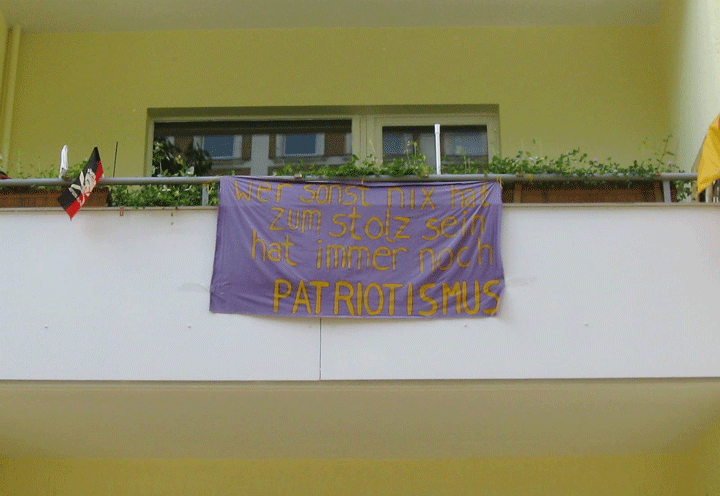
A critical voice in my neighborhood whose apartment is sandwiched between two hardcore soccer enthusiasts (with 6 large German flags flying on each of their balconies) had created a homemade banner that read, “Wer sonst nix hat zum stolz sein hat immer noch PATRIOTISMUS”. Loosely translated it means: For those who have nothing of which to be proud, they always have PATRIOTISM.
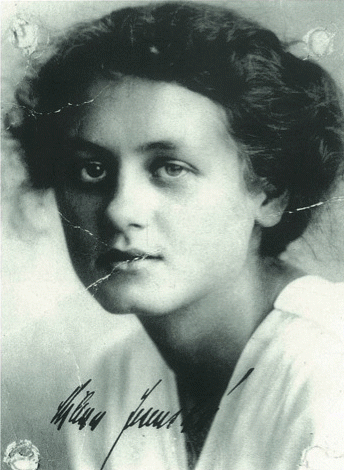
Funny, I don’t feel much like reflecting on a process that I’m currently engaged in- too close- maybe it’s still too near to me.
What I’d rather write about is what I’d like to present for my fragment in Iceland, I have images running around in my head from this past May in Ravensbrück, when I went there to take photos for a Czech newspaper of the opening exhibition, “Milena Jesenská: A Retrospective”.
Ravensbrück was the Nazi’s largest central concentration camp for women from 1939-1945 and Milena Jesenská, the Czech journalist and translator had been deported there in 1940. The exhibition was precipitated by the recent discovery in a Prague archive of 14 little known letters written by Jesenská from prison between 1940-1943 and addressed to her father and 12 year old daughter.
In 1938 and 39, Jesenská edited a prestigious Czech magazine for politics and culture called The Presence. In it she wrote editorials and visionary commentaries on the rise of the Nazi party and the Anschluss of Austria to Nazi Germany and the possible consequences for Czechoslovakia. After the occupation of Czechoslovakia by the German army, she joined an underground resistance movement and helped many Jewish and political refugees to emigrate. In 1939 she was arrested by the Gestapo, imprisoned in Dresden and in October 1940 was deported to Ravensbrück where she died of kidney failure in 1944 at the age of 48.
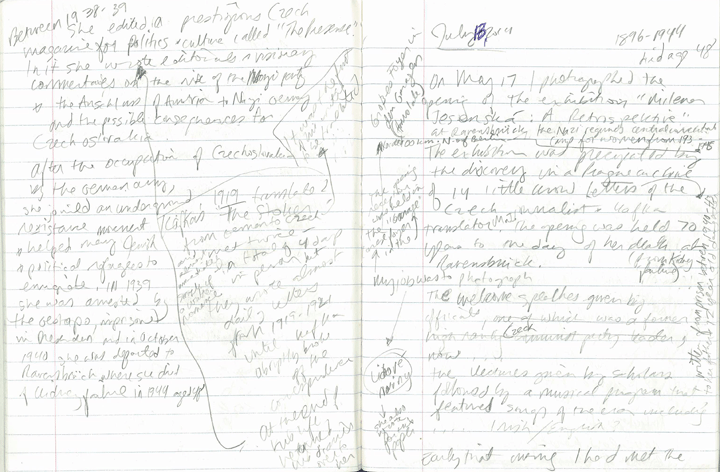
Earlier in her life as a writer and translator, she had read Kafka’s short story, The Stoker and was so taken by it that she persuaded him to allow her to translate it from German into Czech, the first of his writings to be translated into any language. During this process, the already intense intellectual relationship almost immediately developed into an increasingly passionate written correspondence. They met in person only twice for a total of four days but they wrote almost daily letters from 1919-1921. Although it is said that this was the most profound relationship of his life, Kafka broke off the correspondence but at the end of his life he turned all of his diaries over to her and she was the author of his obituary.
The opening exhibition, displaying these 14 newly discovered letters was held at Ravensbrück 70 years to the day of her death there. My job for the Czech newspaper Lidové noviny (a publication Jesenská had previously written for) was to photograph the welcome speeches delivered by museum officials, dignitaries and particularly an esteemed Czech author and biographer of Jesenská. Following the speeches and lectures there was a musical program that featured a female singer with keyboard accompaniment preforming music of the time. The program concluded with coffee and a dry, overly sweet cake being served.
Earlier that morning in Berlin I had met the Czech journalist and writer Ema Procházková and our very pregnant friend, herself an early Soviet film scholar, Adel Svobodová, at the end of the line on the U-1 train, Uhlandstraße. The three of us were being picked up in a car by Adel’s colleague, Ludmila Oblak, an esteemed scholar specialized in Nazi propaganda films.
Sitting in the back seat with Ema, I was futilely tugging at the sleeves of my scratchy woolen dress that I seemed to have shrunk down one or two sizes. This turned out to be exactly the wrong thing to wear especially on a particularly warm day that was getting warmer heading out of Berlin.
Ludmila, although an academic genius, revealed herself quite soon to be contending with some form of high functioning autism that manifested itself in an unending flood of words flowing at fever pitch from her mouth. The content was extremely engaging but the impossibility of anyone else breaking in, even with a question, coupled with her exhausting level of excitement, which was at odds with the dark themes of her work, gave rise to an intense desire of mine to open the door and roll out of the speeding car into the forest.

I really didn’t know what to expect at the camp. Incredibly, I’d never been to one before. Ravensbrück is located in the village of Fürstenburg, about 100 kilometers north of Berlin. Between 1940-1945 120,000 women, 800 children and 20,000 men were prisoners there. They came from 30 different countries. The Jewish, Roma and Sinti were imprisoned without trial on racist grounds, but other prisoners like Jesenská were involved in resistance activities against the Nazi regime, still others were considered “social outsiders” and “criminals”. 27,500 were murdered there and about half of that number, during the last four months before the camp’s liberation. Ashes of the dead were periodically dumped into the Schwedtsee, the same lake that now docks luxury yachts with a view across to the main camp wall.

The opening reception was held in the large foyer of the camp’s garage area just inside the main walls. Listening to the welcome speech, I studied the extensive, sleek architectural renovations of the façade and thought to myself; I could be anywhere right now. This could be anywhere.
The caterers were busily arranging white fabric over round tables behind the crowd of about 100 guests and although we were outside, I felt that stifling sensation again.

She did her job, shot the photos of the important author, read the letters and even stayed through the musical portion. The message came in- I thought it would be nice to meet by a bridge, there’s only one. You’ll find me on the other side of it alongside a trail.

I have to go now. No, no thank you no I won’t need a ride back to Berlin.
She hastily packed up her heavy equipment and suddenly found (it was no longer a choice) that she had to leave this place immediately. She tried to limit herself to walking fast but found herself running through an open gate, onto the main street that ran alongside the camp, running past the empty villas where the highest officials of the camp had once lived.
She waved down the first vehicle to come along; it was a white workers van with a young man driving.
Are you from here?
Yes I was born here. Are you coming from Ravensbrück?
Yes, there is an exhibition today. Have you been there?
No never, too depressing.
He drove along the lake to the only bridge that separates the Schwedtsee with the Balensee and she got out of the van, thanking him, thinking him sweet.
She crossed the bridge and walked slowly along the path until she saw him at an inlet reclined on a fallen down tree trunk, barefoot and reading a book. That’s you, she said, that’s just like you. He slid off the tree and stood in the water. She took off her shoes and walked in to the lake. The hem of her dress sat barely touching the surface of the water. As the crass contradictions and absurdity of the way this day had unfolded suddenly filled her, ashen waters slowly soaked up into the fibers of her dress.
—
This photo essay is a fragment of a 90-minute performance lecture called Four Approaches to the Journal, which was developed and performed in collaboration with Myna Trustram, Per Roar and Camilla Graff Junior on July 27, 2014 in Sauðárkrókur, Iceland. The script combined simultaneous journal-writing with written and transcribed conversations that took place over a five-week period from our respective locations, which encompassed Manchester, Oslo, Berlin, Berkeley and Tallinn. The piece addresses forms of representation and fiction in journal writing and challenges the notion of authorship.